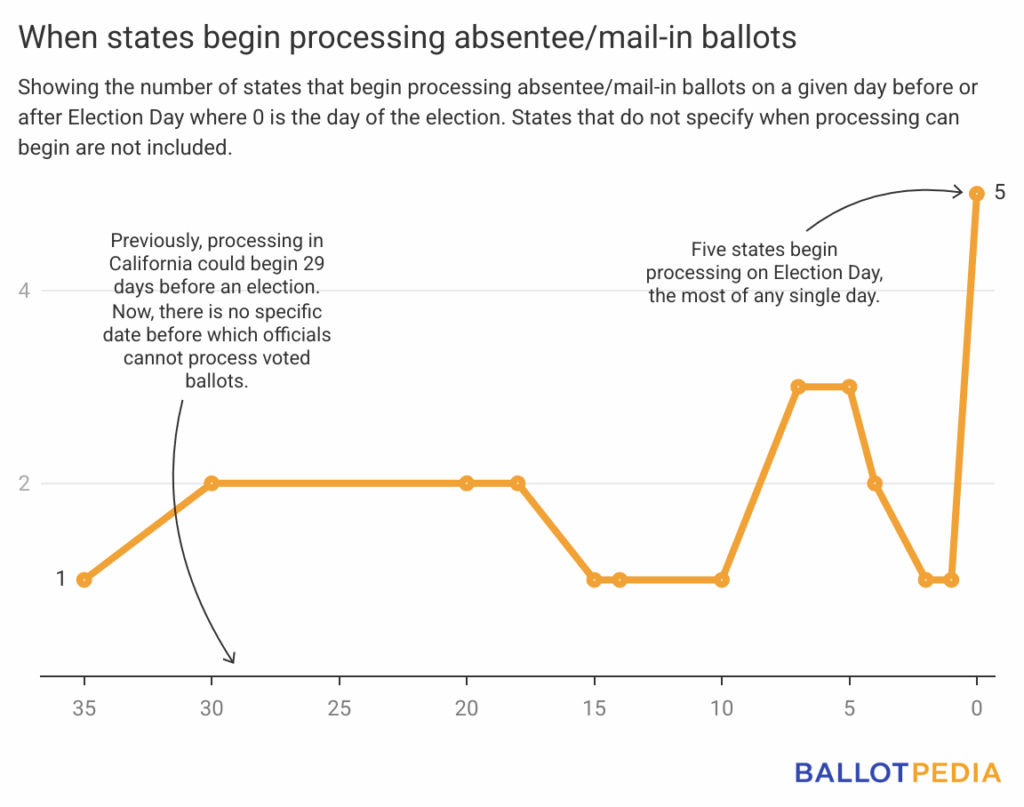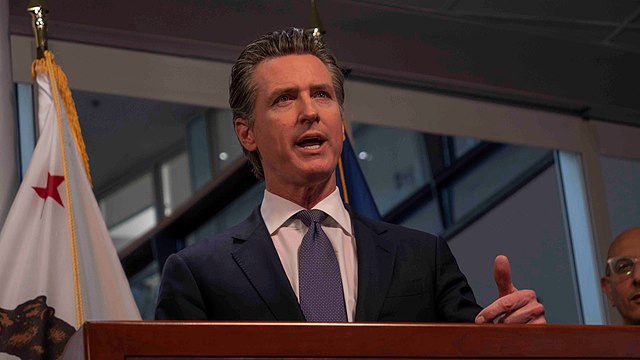California Gov. Gavin Newsom (D) signed three bills into law in the first few days of October that change the state's rules for processing and counting ballots. In some instances, these new laws may result in quicker unofficial election results.
California typically takes longer to deliver election results than most other states. This is partly a result of the state’s all-mail voting system, as election officials must complete certain administrative steps, known as processing, before counting vote-by-mail ballots.
California currently allows election officials to begin processing mail-in ballots 29 days before an election, the fourth-earliest of any state. Assembly Bill 16, which Newsom signed on Oct. 1, allows officials to start processing ballots sooner—at any point after they mail ballots to voters. State law does not set a maximum number of days before an election when election officials can start mailing out ballots.
On Oct. 3, Newsom signed bills on reporting requirements for counted ballots and timelines for curing ballots, both of which also affect how quickly unofficial results are reported.
Assembly Bill 5 requires election officials to count most ballots and release a tally of those ballots no later than 13 days after an election. Previously, no such deadline existed, and most states do not have a specific deadline for counting ballots and reporting results. The new law makes an exception for certain types of ballots, including those that election officials receive more than four days after the election. California law directs election officials to count all valid ballots received up to seven days after an election, as long as the ballot is postmarked by Election Day.
Assembly Bill 827 moves the latest possible date that election officials can notify a voter about a signature defect from the 22nd day after the election to the 14th, and moves the latest possible day for a voter to cure a ballot from the 28th day to the 22nd day after an election, for regular statewide elections.
AB 5 and AB 16 passed the California Legislature with unanimous support. AB 827 passed the California Assembly 60-5, with two Republicans joining 58 Democrats in voting for the bill. It passed the California Senate 30-5, with all voting Republicans in opposition.
Newsom did not release a statement regarding any of the bills.
AB 5 sponsor Assem. Marc Berman (D) wrote, “This bill seeks to maintain voting accessibility and security while also speeding up vote counting by establishing clear and achievable metrics for when the vast majority of ballots must be counted and races decided.” The committee report for the bill stated that Secretary of State Shirley Weber (D) had submitted a letter "[raising] the fiscal issues to comply with this 13-day deadline, the numerous types of exemptions provided by this bill, and the vagueness of the deadline extension process."
AB 16 sponsor Assem. Juan Alanis (R) said that the bill “will allow us to begin verifying signatures, processing ballots, and preparing them for machine counting without compromising the integrity of the election process. … We owe it to our constituents to make sure that their voices are counted as quickly and accurately as possible.” The committee report for AB 16 stated that most election officials in the state already process ballots before Election Day, and said: “it is unclear whether this bill would have a significant effect on the speed at which election results are finalized. On the other hand, this bill would allow elections officials to begin processing those ballots slightly earlier under circumstances, which could improve efficiency of elections officials’ operations.”
Assem. Berman also sponsored AB 827. Berman said that “because there is not a uniform date when counties certify elections, a voter may not know the date by which to make the correction and could inadvertently miss the deadline. AB 827 would provide voters with greater certainty if they are notified of missing or non-matching signature, ensuring that everyone is operating on a level playing field.” The committee report stated, “While setting an earlier cure deadline may allow some counties to certify their election results earlier than in the 2024 general election, it may also reduce the number of ballots that are able to be counted if voters do not complete the cure process by the earlier deadline.”
Timelines for election officials to process and count absentee/mail-in ballots, and the steps officials are permitted to take during processing, vary nationwide. Nineteen states permit election officials to fully process and scan at least some early and absentee/mail-in ballots before Election Day. Twenty-six states and D.C. permit officials to process at least some aspects of these ballots before Election Day. In five states, election officials do not begin any aspect of processing absentee/mail-in ballots until Election Day.

In addition to processing and counting rules, other factors affect how quickly unofficial results are reported. These include the resources available to election officials, deadlines for returning absentee/mail-in ballots, provisional ballot procedures, and the presence of jurisdictions that hand-count ballots. Any one of these issues might play a role in how quickly results are reported. Click here for an explanation of these variables and a breakdown of policies in California.


